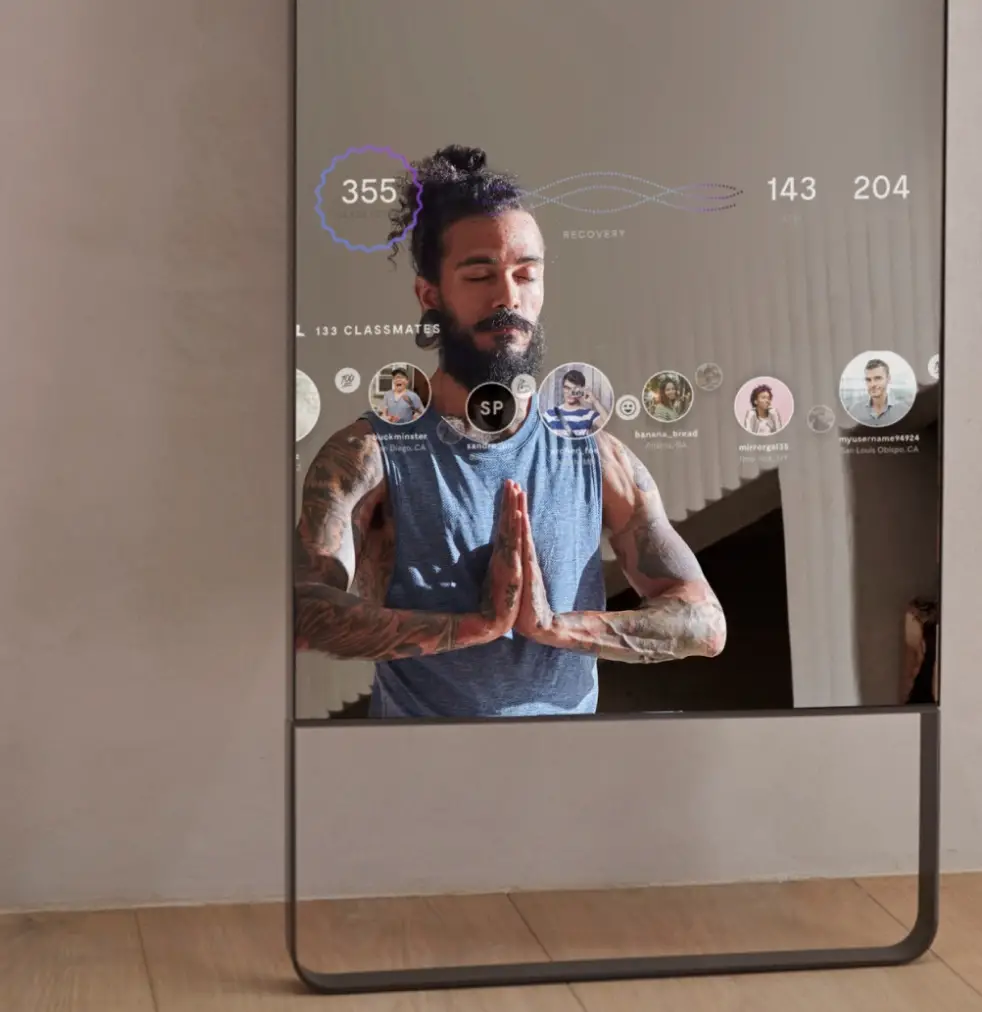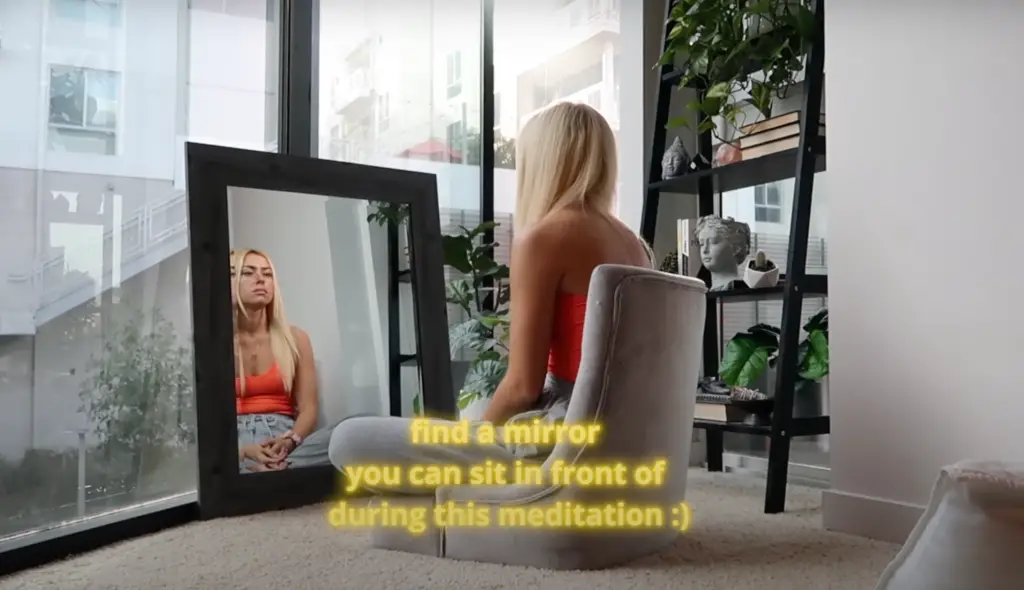Even before Socrates said his philosophy-defining quote, “Know thyself,” human beings have searched for their capabilities and purpose in life.
In search of the truth, we’ve looked on top of the highest peaks and peered into the deepest depths of the sea. However, most of us forget to simply look closely into ourselves.
This is where mirror meditation comes in. Gazing into one’s own eyes can help put our hearts at ease, thus reducing self-objectification and anxiety and allowing one to have a stress-proof brain.
In this article, we’ll discuss what mirror meditation is in detail, how you can perform it, and what benefits it reaps.
So, let’s delve right into it.

What Is Mirror Gazing Meditation?
Let’s take a look at what mirror gazing is. This form of meditation involves gazing into your reflection in the mirror.
Not simply gazing but a deep and direct gaze at your reflection. The practitioners mainly opt for this to remove self-judgment as much as possible.
As human beings, most of us are extremely judgmental of ourselves. We spend a major chunk of our day thinking of ourselves, like whether we are presentable or not, how people perceive us or may perceive us, etc.
Plus, we are so self-judgmental that we fail to control our own emotions and waste a lot of time on these. It’s so deeply rooted in us that we often fail to acknowledge its existence.
This comes from our childhood because, as children, we tend to find ourselves in the reflections of the people around us.
In fact, psychological research has proven that we require a lot of face-to-face contact for the growth of our social and emotional development.
In fact, as children, we often look into our own reflection in not only mirrors but also reflective surfaces such as a shiny chrome toaster or an oven. We do this simply to explore our features more closely.
As we start growing up, we get burdened with different societal expectations. Thus, we start focusing on how we look instead of how we feel.
We start comparing ourselves with the standards set by the media and fail to truly love ourselves for who we really are.
And this is where mirror meditation comes in. This practice tends to induce a feeling of greater self-compassion in the hearts of the practitioners.
Not only that, but mirror meditation can teach you to live in the present moment, decrease negative emotions, and even help improve surface appearance and promote positive body language.
Is Mirror Meditation the Same as Other Forms of Meditation?
Due to a lack of information, you may feel that one meditation practice is no different or barely different from another one. However, most of these practices are completely different.
That being said, mirror meditation is in a category of its own.
Yes, mirror meditation shares some traits with other forms of meditation because it will make you more aware of what you’re feeling moment-to-moment. It will also help you ground your thoughts more, allowing you to feel calmer and more relaxed.
Most forms of meditation don’t focus on our outer appearances.
You may understand the fact that attractive facial features don’t necessarily equate to attractive personality traits. Yet, you may not reflect that in your actions and be overcome with self-awareness.
Mirror meditation focuses on your outward appearance just as much as your inner peace. With proper face-to-face reflection, you have higher chances of increasing self-awareness.
Now, you may think about whether mirror meditation actually works or not. If so, how?
The answer is simple. Our eyes express our emotions in the best possible manner.
By peering into your eyes long enough and by making them the focal point, you’ll be able to understand your deepest emotions and self-consciousness.
With a greater understanding of yourself will come deep understanding and greater self-confidence.
How to Perform

One of the nicest things about mirror gazing is its accessibility. You don’t need the help of a professional to get started with mirror gazing, unlike many other forms of meditation.
In this section, we’ll discuss how to perform mirror meditation in detail.
Select a Place
Mirror meditation can be performed almost everywhere once you get used to it.
However, initially, it’s best performed in an isolated and comfortable place. When getting into it, you’ll have a hard time focusing.
So, the goal should be to get rid of as many distractions as possible.
You can sit on a pillow, chair, or even on your bed, whatever feels the most comfortable to you. Put a mirror in front of you at 90 degrees.
Another important pointer, make sure you have no makeup on so you can connect to yourself in the purest of forms. This will play a great role in increasing self-acceptance.
Focus
Once you have the right place and sitting position, it’s time to focus on yourself and cut off any worldly thoughts. As we’ve discussed, being in front of the mirror for the first time can be daunting for some.
You can try out some practices for reducing self-criticism and allowing room for self-compassion.
For example, start with fixing your posture. Grand Master Akshar, a mirror-gazing expert, encourages his students to perform the “Tratak” meditation prior to mirror gazing because this helps to calm one’s nerves and also builds focus.
While mirror gazing, chances are that you’ll be sitting for quite a while. Even sitting for a long while can get tiring.
This is why experts suggest you sit in the “Sukhasana” position. To make things easier, here’s a description of the position.
With your bottom on the floor, cross your legs in such a manner that they’re directly below your knees.
Now, rest your hands on your knees with your palms facing downwards.
Then, straighten your spine and drop your shoulders and back. Make sure your chest is pressed forwards.
Relax the rest of your body. This will help you stay relaxed for a long time without any stress, allowing you to focus completely on your meditation.
Apart from this, you can also try out different breathing practices like deep belly breaths.
Set a Timer
You don’t have to push yourself to do hours of mirror gazing a day when you start out. In fact, even a few minutes will feel like an eon in the beginning.
So, it’s recommended that you start out with only two to three minutes. Once you’re comfortable with that, increase that to five minutes and finally to ten minutes.
Stare Directly at Your Eyes
Once you’re done setting the timer and fixing the right position, it’s time to lock your gaze on the reflection of your eyes.
Keeping your gaze fixated on the eyes can be tough at first, but don’t give up. Try your best to keep your eyes on them consciously.
In this step, it’s important to figure out if you feel uncomfortable or not. Look out for pointers like if you feel uncomfortable, or certain areas are just tensing up, or if you have weird expressions or not.
Despite these, try not to judge yourself. This practice will help you build up emotional resilience, which in turn will help shift self-criticism to increase self-compassion.
Calm Your Mind
Like most other forms of mindfulness meditation, you’ll have to perform some stress management.
While you’re engrossed in self-reflection, your inner critic is supposed to awaken, and your mind is bound to let deeply rooted thoughts float to the surface.
In these instances, you will have to shift your focus back to your eyes and breathing.
Consistency Is the Key
It won’t help if you perform this mirror-based meditation program for hours but irregularly.
To understand your personality psychology and to overcome self-criticism so you can live a full and authentic life, you will have to be consistent.
Try to perform at least a 5-minute mirror meditation session a day.
Mirror Gazing Can Evoke Strong Feelings
People often tend to avoid looking in the mirror unless they need to. This is because we’re often afraid of coming face to face with ourselves.
Mirrors are extremely strong tools because they can help us understand who we really are.
Human beings have a perceived image of who they are, and that mostly doesn’t align with who they really are. So, the thought of acknowledging their true self instigates fear.
Moreover, the recent innovations involving screens and other digital technology have decreased the chances of coming face to face with ourselves or other people.
In a recent Neilsen study, it was stated that we spend an average of 11 hours behind screens every day.
Furthermore, a research scientist from the National Center for Biology has mentioned that the more anxious a person is, the more likely he is to reach out for a screen.
Although it’s unsure whether screens cause anxiety or anxiety makes one reach for more screens, it’s clear that increased screen times keep us from reflecting on life, thus increasing anxiety even more.
Whenever you start mirror meditation, don’t expect instant returns. Rather, this can take some time to get used to.
At first, you may feel awkward. In fact, you may even feel anxious. However, this feeling will go away over time.
That’s when you will start focusing on your outer appearance. While the eyes will be the focal point, you will drift off to other areas of your body as well.
With time and enough focus, you’ll finally be able to look into yourself through your eyes, and that is when a whole new world will start opening up to you.
Conclusion
Mirror meditation blends social psychology, clinical psychology, as well as personal psychology and provides a truly unique offering that can help you tame your mind.
To enhance your mental health, it’s important to understand one’s own image and emotional awareness.
You can understand these with your own gaze, but you will have to be focused and consistent.
Hopefully, this article provided all the information you needed to get started with mirror meditation. For more trivia and interesting facts, you can follow the personality psychology podcast.
